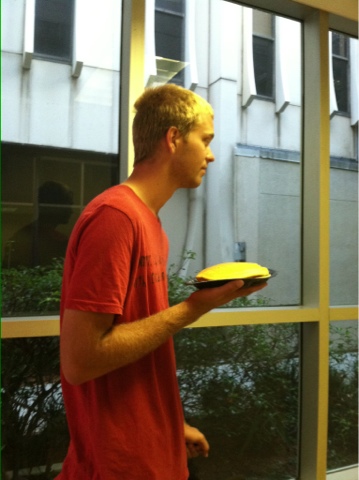•Choose your paint color to scratch off and mix it with dish soap; 2 parts dish soap, 1 part paint
Sunday, December 22, 2013
Our Gender Reveal and Homemade Scratch Card Instructions
•Choose your paint color to scratch off and mix it with dish soap; 2 parts dish soap, 1 part paint
Monday, December 16, 2013
Boaz's 3rd Diagnosis....
Early last week, we had to get blood work done for Boaz. It was just routine endocrine blood work and he did AMAZINGLY getting it drawn. Then we got a call that some of his levels were elevated and we needed to do a repeat. So we went back to Nemours (which thankfully is only 30 minutes away now) and had more blood drawn. I got a call from his doctor ealier today telling me that his levels were indeed too high, and that he officially has Hashimotos's. We are starting him on some thyroid hormone therapy, and....yeah, that's all I've got to say. We have a lot to learn!
Hypothyroidism. Hypothyroidism is when the levels of thyroid hormones in the blood are abnormally low. Thyroid hormone deficiency slows body processes and may lead to fatigue, a slow heart rate, dry skin, weight gain, constipation, and, in kids, slowing of growth and delayed puberty.
Hashimoto's thyroiditis, which results from an autoimmune process that damages the thyroid and blocks thyroid hormone production, is the most common cause of hypothyroidism in kids. Infants can also be born with an absent or underdeveloped thyroid gland, resulting in hypothyroidism. It can be treated with oral thyroid hormone replacement.
Cloth Diapering: Rookie Mistakes
Sunday, December 8, 2013
A Great Reminder!
Wednesday, November 20, 2013
World Diabetes Day!
Monday, November 4, 2013
Blood in the Pump Tubing? Problem Solved
Sunday, November 3, 2013
497. 152. 155.
Pray for Boaz
Thursday, October 31, 2013
Type 1 Diabetes Day!
Wednesday, October 30, 2013
ToddlerMeal: Garbanzo Beans
Tuesday, October 22, 2013
Toddler Meal: Pimento Cheese Recipe
Saturday, October 19, 2013
Pray for Emory
Friday, October 11, 2013
October is Down Syndrome Awareness Month!
Down syndrome occurs when an individual has a full or partial extra copy of chromosome 21. This additional genetic material alters the course of development and causes the characteristics associated with Down syndrome.
- There are three types of Down syndrome: trisomy 21 (nondisjunction) accounts for 95% of cases, translocation accounts for about 4% and mosaicism accounts for about 1%.
- Down syndrome is the most commonly occurring chromosomal condition. One in every 691 babies in the United States is born with Down syndrome.
- There are more than 400,000 people living with Down syndrome in the United States.
- Down syndrome occurs in people of all races and economic levels.
- The incidence of births of children with Down syndrome increases with the age of the mother. But due to higher fertility rates in younger women, 80% of children with Down syndrome are born to women under 35 years of age.
- People with Down syndrome have an increased risk for certain medical conditions such as congenital heart defects, respiratory and hearing problems, Alzheimer's disease, childhood leukemia, and thyroid conditions. Many of these conditions are now treatable, so most people with Down syndrome lead healthy lives.
- A few of the common physical traits of Down syndrome are low muscle tone, small stature, an upward slant to the eyes, and a single deep crease across the center of the palm. Every person with Down syndrome is a unique individual and may possess these characteristics to different degrees or not at all.
- Life expectancy for people with Down syndrome has increased dramatically in recent decades - from 25 in 1983 to 60 today.
- People with Down syndrome attend school, work, participate in decisions that affect them, and contribute to society in many wonderful ways.
- All people with Down syndrome experience cognitive delays, but the effect is usually mild to moderate and is not indicative of the many strengths and talents that each individual possesses.
- Quality educational programs, a stimulating home environment, good health care, and positive support from family, friends and the community enable people with Down syndrome to develop their full potential and lead fulfilling lives.
USE THIS LANGUAGE WHEN REFERRING TO DOWN SYNDROME AND PEOPLE WHO HAVE DOWN SYNDROME:
- People with Down syndrome should always be referred to as people first. Instead of "a Down syndrome child," it should be "a child with Down syndrome." Also avoid "Down's child" and describing the condition as "Down's," as in, "He has Down's."
- Down syndrome is a condition or a syndrome, not a disease.
- People "have" Down syndrome, they do not "suffer from" it and are not "afflicted by" it.
- Down vs. Down's - NDSS uses the preferred spelling, Down syndrome, rather than Down's syndrome. While Down syndrome is listed in many dictionaries with both popular spellings (with or without an apostrophe s), the preferred usage in the United States is Down syndrome. This is because an "apostrophe s" connotes ownership or possession. Down syndrome is named for the English physician John Langdon Down, who characterized the condition, but did not have it. The AP Stylebook recommends using "Down syndrome," as well.
- While it is still clinically acceptable to say "mental retardation," you should use the more socially acceptable "intellectual disability" or "cognitive disability." NDSS strongly condemns the use of the word "retarded" in any derogatory context. Using this word is hurtful and suggests that people with disabilities are not competent.
Friday, October 4, 2013
Buddy walk!
Saturday, September 28, 2013
Our Crazy Night with Diabetes
Sunday, September 15, 2013
Some Call Us Crazy
Type 1 Diabetes Awareness Day!
Wednesday, September 4, 2013
DIY: Washi Tape Candle
Please Pray!
Tuesday, September 3, 2013
Why Another Church?
1. Quotations are from Michael Horton, No Church, No Problem?




























































